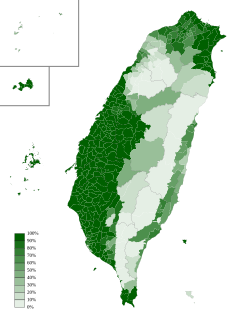
Taiwanese, also known as Taigi, Taiwanese Hokkien, Taiwanese Minnan, Hoklo and Holo, is a variety of the Hokkien language spoken natively by about 70% of the population of Taiwan. It is spoken by the Taiwanese Hoklo people, who descended from immigrants from southern Fujian during the Qing dynasty. The Pe̍h-ōe-jī (POJ) romanization is a popular orthography for Taiwanese.

Southern Min, Minnan or Banlam, is a group of linguistically similar and historically related Sinitic languages that form a branch of Min Chinese spoken in Fujian, most of Taiwan, Eastern Guangdong, Hainan, and Southern Zhejiang. The Minnan dialects are also spoken by descendants of emigrants from these areas in diaspora, most notably the Philippines, Indonesia, Malaysia, Singapore, San Francisco, Los Angeles and New York City. It is the most populous branch of Min Chinese, spoken by an estimated 48 million people in ca. 2017–2018.
Taiwanese Americans are Americans who carry full or partial ancestry from Taiwan. This includes American-born citizens who descend from migrants from Taiwan.

The Chinese people or simply Chinese, are people or ethnic groups identified with China, usually through ethnicity, nationality, citizenship, or other affiliation.

Cantonese is a language within the Chinese (Sinitic) branch of the Sino-Tibetan languages originating from the city of Guangzhou and its surrounding area in Southeastern China. It is the traditional prestige variety of the Yue Chinese dialect group, which has over 80 million native speakers. While the term Cantonese specifically refers to the prestige variety, it is often used to refer to the entire Yue subgroup of Chinese, including related but largely mutually unintelligible languages and dialects such as Taishanese.
Chinese-Burmese, also Sino-Burmese or Tayoke, are a group of overseas Chinese born or raised in Myanmar (Burma). Among the under-documented Chinese populations are those of mixed background but are not counted due to the lack of reliable census taking. As of 2012, the Burmese Chinese population is estimated to be at 1.6 to 3.0 million.
Language shift, also known as language transfer or language replacement or language assimilation, is the process whereby a speech community shifts to a different language, usually over an extended period of time. Often, languages that are perceived to be higher status stabilise or spread at the expense of other languages that are perceived by their own speakers to be lower-status. An example is the shift from Gaulish to Latin during the time of the Roman Empire.

Chinese Singaporeans are Singaporeans of Chinese ancestry. Chinese Singaporeans constitute 76.2% of the Singaporean population, making them the largest ethnic group in Singapore.

The Hoklo people are Han Chinese people whose traditional ancestral homes are in southern part of Fujian, China. They are speakers of Hokkien, a language in the Southern Min language family, and known by various endonyms, or other related terms such as Banlam (Minnan) people or Hokkien people. There are significant populations in Taiwan, Malaysia, Singapore, Indonesia and the Philippines.
The subgroups of the Han Chinese people, Chinese dialect groups or just dialect groups, are defined based on linguistic, cultural, ethnic, genetic and regional features. The terminology used in Mandarin to describe the groups is: "minxi", used in Mainland China or "zuqun", used in Taiwan. No Han subgroup is recognized as one of People's Republic of China's 56 official minority ethnic groups. Scholars like James W. Hayes have described the Han Chinese subgroups as "ethnic group" outright, at least in the context of Hong Kong society.
Taiwanese people may be generally considered the people of Taiwan who share a common culture, ancestry and speak Taiwanese Mandarin, Hokkien, Hakka or indigenous Taiwanese languages as a mother tongue. Taiwanese people may also refer to the indigenous peoples of the areas under the control of the Government of the Republic of China since 1945, including Penghu, Kinmen and Matsu Islands.

The languages of Taiwan consist of several varieties of languages under the families of Austronesian languages and Sino-Tibetan languages. The Formosan languages, a branch of Austronesian languages, have been spoken by the Taiwanese aborigines in Taiwan for thousands of years. Owing to the wide internal variety of the Formosan languages, research on historical linguistics recognizes Taiwan as the Urheimat (homeland) of the whole Austronesian languages family. In the last 400 years, several waves of Han emigrations brought several different Sino-Tibetan languages into Taiwan. These languages include Taiwanese Hokkien, Hakka, and Mandarin, which have become the major languages spoken in Taiwan nowadays.
Taiwanese units of measurement are the customary and traditional units of measure used in Taiwan. The Taiwanese units formed in the 1900s when Taiwan was under Japanese rule. The system mainly refers to Japanese system. The measurement refers to the traditional size of a Japanese flooring mat called a Tatami mat which were positioned to completely cover the floor of traditional Japanese homes, therefore it became a convenient measurement tool as mat area was standardised hundreds of years ago. In Taiwan the measurement units are pronounced in Taiwanese Hokkien and Hakka before the World War II and adopted by the Mandarin speaking immigrants from China in 1949. Today, the Taiwanese units are used exclusively, in some cases alongside official SI units, and in other cases they have been replaced by SI.
Taiwanese Canadians are Canadian citizens who carry full or partial ancestry from the East Asian island country of Taiwan or from preceding Taiwanese regimes. This includes Canadian-born Taiwanese (CBT).

The population of Taiwan is approximately 23.45 million, spread across a total land area of about 36,000 km2 (14,000 sq mi); it is the seventeenth most densely populated country in the world, with a population density of about 651 inhabitants per square kilometer.
The Teochew people are a Han Chinese people native to the historical Teochew prefecture of eastern Guangdong province who speak the Teo-Swa Min language. Today, most Teochew people live in Hong Kong, Guangdong Province, and also outside China in Southeast Asia, including in Singapore, Malaysia, Thailand, Cambodia, Vietnam, Philippines, and Indonesia. The community can also be found in diasporas around the world, including the United States, Canada, Australia, New Zealand, and France.
Native Taiwanese, also known as Pún-síng-lâng, Han-tsî-á or Benshengren, are Taiwanese peoples who settled on the island prior or during Japanese colonization of Taiwan. Its usage is to differentiate the different culture, customs, and political sentiments within contemporary Taiwan between those who lived through World War II on the island and later migrants from China. Hoklo and Hakka people who migrated to Taiwan with the Nationalist-Led Chinese Government colonization since October 25, 1945 are not included in this term.

Hokkien, a Min Nan variety of Chinese spoken in Southeastern China, Taiwan and Southeast Asia, does not have a unitary standardized writing system, in comparison with the well-developed written forms of Cantonese and Vernacular Chinese (Mandarin). In Taiwan, a standard for Written Hokkien has been developed by the Republic of China Ministry of Education including its Dictionary of Frequently-Used Taiwan Minnan, but there are a wide variety of different methods of writing in Vernacular Hokkien. Nevertheless, vernacular works written in the Hokkien are still commonly seen in literature, film, performing arts and music.
Han Taiwanese or Taiwanese Han are a Taiwanese ethnic group, most of whom are of full or partial Han descent. According to the Executive Yuan of Taiwan, they comprise 95 to 97 percent of the Taiwanese population, which also includes Austronesians and other non-Han people. Major waves of Han immigration occurred since the 17th century to the end of Chinese Civil War in 1949, with the exception of the Japanese colonial period (1895-1945). Han Taiwanese mainly speak three languages of Chinese: Mandarin, Hokkien and Hakka.
The usage of Chinese by the Chinese diaspora and their descendants has been determined by a large number of factors, including their ancestry, their migrant ancestors' "regime of origin", assimilation through generational changes, and official policies of their country of residence. The general trend is that more established Chinese populations in the Western world and in many regions of Asia have Cantonese as either the dominant variety or as a common community vernacular, while Mandarin is much more prevalent among new arrivals, making it increasingly common in many Chinatowns, though still not dominant.








